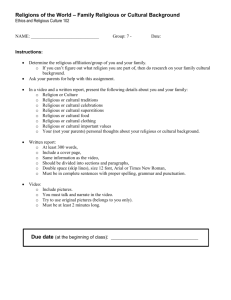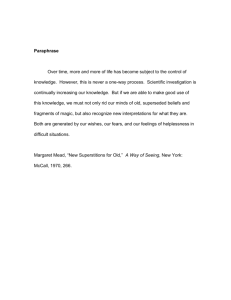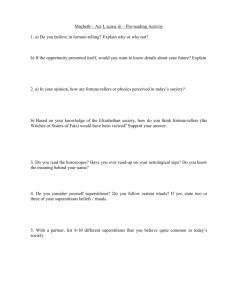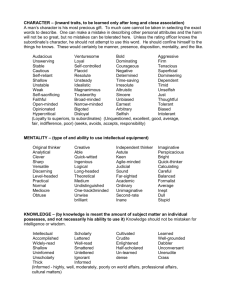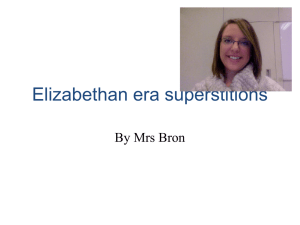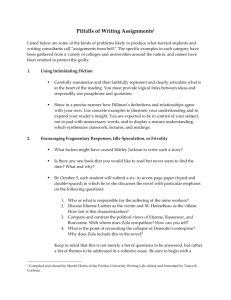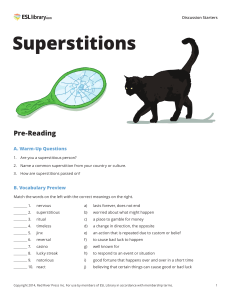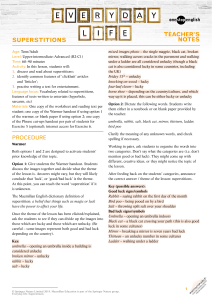What is critical thinking?
advertisement
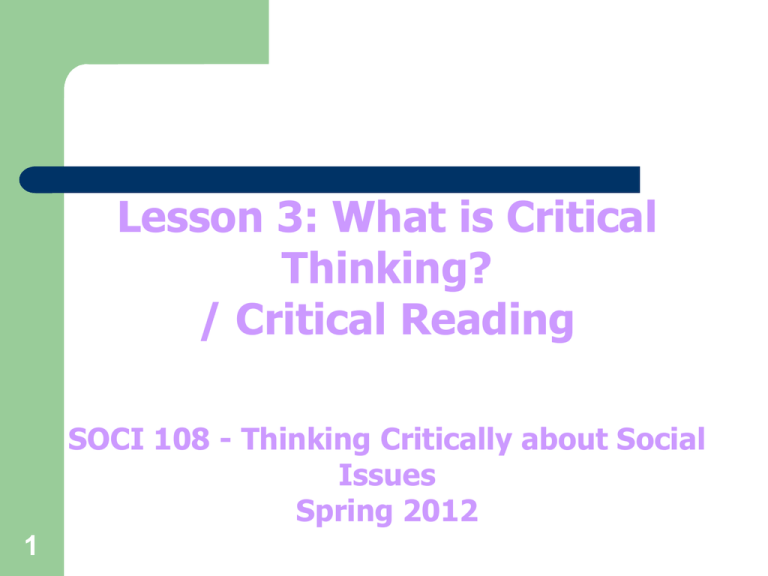
Lesson 3: What is Critical Thinking? / Critical Reading SOCI 108 - Thinking Critically about Social Issues Spring 2012 1 Learning Outcomes • Define critical thinking • Evaluate your learning style • Recall characteristics of critical thinkers • Apply the six tasks of effective critical thinking 2 Current Social Issues 3 What are some examples of current social issues which have a multitude of possible positions? Current Social Issues (cont) 4 Do any of these have one right answer? Many sides to social issues Make intelligent guesses/decisions about what to believe Thinking is biased, distorted, partial, uninformed, or prejudiced As the world becomes more complex, we tend to depend on others to filter information for us—we can’t be experts on everything Learning channel / style Exercise 5 Workbook page 10-13 What is Critical Thinking? 6 Critical thinking is reasonable, reflective thinking that is focused on deciding what to believe or do. Can you tell the difference between “well supported” and “widely accepted” ideas? – – What makes something well-supported? – – 7 Superstitions are often widely accepted What are some superstitions that people believe? Evidence Facts A Well-cultivated Critical Thinker: 1) Raises vital questions and problems, formulating them clearly and precisely 1) 2) Gathers and assesses relevant information 1) 3) 8 Eg: why this pattern? Eg: Will more data support the pattern? Comes to well-reasoned conclusions and solutions, testing them against relevant criteria and standards A Well-cultivated Critical Thinker: 4) Thinks open-mindedly within alternative systems of thought, recognizing and assessing their assumptions, implications, and practical consequences 1) 5) 9 Eg: really look at the other side Communicates effectively with others in figuring out solutions to complex problems. 6 Tasks to Effective Critical Thinking: 1) Knowledge 2) Comprehension 10 Reading, listening, and discussing Understand what you read and hear Restate in your own words Word meaning, e.g. cell Context – how it is used and when change the meaning 6 Tasks to Effective Critical Thinking: 3) Application Apply to situations Give examples Knowledge=beliefs influence perceptions and vice versa Application: 3 umpires: 11 #1: “I call them as I sees ‘em.” #2: “I call them as they are.” #3: “They ain’t nothing ‘til I calls ‘em.” 6 Tasks to Effective Critical Thinking: 4) Analysis 5) Synthesis Combine the parts with other parts to make a new whole 6) Legos=make what’s on the box, application Combine two or more boxes to make a new structure=synthesis Evaluation 12 Break it down into component parts Deconstruct the knowledge What does family mean to you? Who is a part of it? Judge its worthiness Weigh the argument Critical Reading Skim – – – – – Article: 5-10 min Book: 15-20 min What is the author’s position What are the relevant subtopics? Evidence? Reflect – 13 What type? – Your views on the topic? Your biases? Critical Reading Read – – – – Evaluate – – – 14 Deepen and refine understanding Underline, highlight sparingly Summarize in writing Translate into your own words Read over your summary Vague terms—look up! Emotionally charged language? Feel and think is ok, NOT feel instead of think
